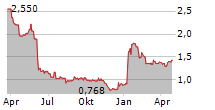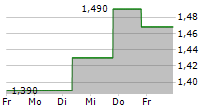
PRESS RELEASE
AB SCIENCE PROVIDES AN UPDATE ON THE MICROTUBULE PROGRAM AB8939 AND IN PARTICULAR THE ABILITY OF AB8939 TO GENERATE RESPONSE ON MECOM REARRANGEMENT
Paris, 26 September 2024, 8.30am CET
AB Science SA (Euronext - FR0010557264 - AB) today provides an update on the microtubule program AB8939 and in particular the ability of AB8939 to generate response on MECOM rearrangement.
AB8939 is a novel microtubule destabilizer currently evaluated in phase 1 clinical trial (study AB18001, NCT05211570) in patients with refractory and relapsed acute myeloid leukemia (AML).
The phase 1 clinical trial of AB8939 completed its first step, consisting in determining the maximum tolerated dose following 3 consecutive days of AB8939 treatment, and was authorized to proceed with the next step, consisting in determining the maximum tolerated dose following 14 consecutive days of AB8939 treatment.
The phase 1 clinical trial continues to determine MTD and the study is now at the last cycle of the 14 days evaluation.
The next step will be to determine the MTD in the combination of AB8939 with Vidaza® (azacitidine).
AB Science previously reported [1] a case of complete bone marrow response in an AML patient in failure to prior treatment with azacitidine and presenting with a MECOM gene rearrangement, which consists of chromosomic aberrations of EVI1 oncogene, leading to one of the worst prognostics in AML and is associated with lack of response and resistance to conventional chemotherapy.
New data confirm that there is a signal of activity against MECOM, with AB8939 generating a complete response in combination with Vidaza, as evidenced by a synergistic effect in a patient-derived xenograft (PDX) mouse model bearing the MECOM rearrangement. PDX are cell lines coming from patients that are grafted to immune deficient mice to mimic as closely as possible the human disease.
- AB8939 was able to generate 50% response when used as a single agent on MECOM cell lines ex vivo in a non-clinical setting.
- In the phase 1 trial, 4 patients bore the MECOM rearrangement and 50% responded to AB8939 when used as a single agent.
- In phase 1, so far, AB8939 does not appear to be toxic to bone marrow, avoiding severe neutropenia and suggesting the possibility to use the drug for long-term treatment.
These data taken together confirm the opportunity to develop AB8939 in phase 2 clinical trial in MECOM as a single agent or in combination with Vidaza.
The advantage is that a small study could be sufficient to comply with FDA guideline on accelerated approval.
Professor Olivier Hermine, President of the AB Science Scientific Committee and member of the French Academy of Sciences and Head of haematology Department at Necker Hospital commented: "AB8939 can be developed in the other patients suffering from AML, but MECOM represents a real opportunity to use the accelerated approval pathway, since it lacks treatment, patients are unresponsive to existing therapy and survival is usually inferior to 6 months. A phase 2 with a limited sample size, non-controlled, and showing a 30% response rate at month 3, with a survival potential at 6 months would probably be convincing enough for an accelerated approval. This will be discussed with FDA in future regulatory milestone. This study could be implemented in 2025. Moreover, MECOM extends beyond AML and are present in high-risk myelodysplasia (MDS) and ovarian cancer."
Two patents have been filed protecting AB8939 in AML, one global composition of matter (granted) and a second one protecting the use of AB8939 in cancers displaying MECOM rearrangement (pending), with protection until 2036 and 2044 respectively.
About MECOM
AML represents a heterogeneous group of diseases with different responses to treatment, which can be separated by genetic abnormalities. Overexpression of MECOM occurs in approximately 10% of AML patients and is associated with a poor prognosis, in part due to its important role in the maintenance of leukemic stem cells (LSCs) [2]. Because of their quiescent (inactive) state, LSCs are not targeted by any antimitotic chemotherapy and can therefore re-establish the disease after therapy.
About AB8939
AB8939 is a new synthetic microtubule-destabilizing drug. Preclinical data show that AB8939 has broad anticancer activity [3-5], with a notable advantage over standard chemotherapies that target microtubules of being able to overcome P-glycoprotein (Pgp) and myeloperoxidase (MPO) mediated drug resistance. Development of drug resistance often restricts the clinical efficacy of microtubule-targeting chemotherapy drugs (for example, taxanes and vinca alkaloids); thus, AB8939 has strong potential to be developed in numerous oncology indications.
AB8939 was granted orphan drug designation for AML from the U.S. Food and Drug Administration (FDA).
AB8939 was entirely discovered by the laboratories of AB Science, which retains full ownership of intellectual rights, and is an example of AB Science's focus on innovative drug development focused on improving patients' lives.
The first indication AB8939 is being developed for is acute myeloid leukemia (AML). Cytarabine (Ara-C) and azacytidine are standard chemotherapies for AML treatment, however, drug resistance is a major limitation to successful therapy. In vivo data from a highly resistant Ara-C patient derived xenograft (PDX) mouse model showed that AB8939, administered alone or in combination with Ara-C, increased survival relative to single agent Ara-C, with an accompanying significant reduction of blasts in blood and decrease in tumor growth. Further evidence of therapeutic potential was demonstrated using an azacytidine resistant PDX model with AB8939, administered alone or in combination with azacytidine, showing a significant reduction of blasts relative to single agent azacytidine. Moreover, while azacytidine was associated with strong treatment related hematotoxicity, AB8939 did not induce hematotoxicity throughout its 4-week treatment period.
About acute myeloid leukemia (AML)
Acute myeloid leukemia (AML) is a serious, life-threating condition and the most common cause of leukemia-related mortality, with a majority of patients facing a highly unsatisfactory prognosis. As such, AML represents an unmet medical need, with limited therapeutic options for patients who are refractory or too frail to benefit from potentially curative but highly toxic treatment, or for those patients that have relapsed following a first complete response. The prevalence of AML in western countries is around 1 per 5,000 persons, corresponding to around 100,000 cases in Europe and 60,000 in the USA. Among AML patients, it is estimated that approximately 50% of the patients will not have stem cell transplantation and will relapse. Therefore, the estimated targeted population of AB8938 in AML is around 80,000 people in Europe and the US.
References
[1] AB Science press release dated 13 March 2023
[2] Paubelle E, Plesa A, Hayette S, et al. Efficacy of All-Trans-Retinoic Acid in High-Risk Acute Myeloid Leukemia with Overexpression of EVI1. Oncol Ther. 2019;7(2):121-130. Doi:10.1007/s40487-019-0095-9
[3] Goubard A, Humbert M, Mansfield C, Hermine O, Dubreuil P, et al. In Vivo Assessment of the Next Generation Microtubule-Destabilizing Agent AB8939 in Patient-derived Xenograft Models of Acute Myeloid Leukemia. Blood (2019) 134 (Supplement_1): 5142. doi.org/10.1182/blood-2019-127143
[4] Goubard A, Humbert M, Mansfield C, Hermine O, Dubreuil P, et al. AB8939, a Microtubule-Destabilizing Agent with Potential to Overcome Multidrug Resistance, is Active Across the Range (M0-M7) of Acute Myeloid Leukemia Subtypes. Blood (2019) 134 (Supplement_1): 5154. doi.org/10.1182/blood-2019-127021
[5] Humbert M, Goubard A, Mansfield C, Hermine O, Dubreuil P, et al. Anticancer Activity of a Highly Potent Small Molecule Tubulin Polymerization Inhibitor, AB8939. Blood (2019) 134 (Supplement_1): 2075. doi.org/10.1182/blood-2019-122540
About AB Science
Founded in 2001, AB Science is a pharmaceutical company specializing in the research, development and commercialization of protein kinase inhibitors (PKIs), a class of targeted proteins whose action are key in signaling pathways within cells. Our programs target only diseases with high unmet medical needs, often lethal with short term survival or rare or refractory to previous line of treatment.
AB Science has developed a proprietary portfolio of molecules and the Company's lead compound, masitinib, has already been registered for veterinary medicine and is developed in human medicine in oncology, neurological diseases, inflammatory diseases and viral diseases. The company is headquartered in Paris, France, and listed on Euronext Paris (ticker: AB).
Further information is available on AB Science's website:
www.ab-science.com.
Forward-looking Statements - AB Science
This press release contains forward-looking statements. These statements are not historical facts. These statements include projections and estimates as well as the assumptions on which they are based, statements based on projects, objectives, intentions and expectations regarding financial results, events, operations, future services, product development and their potential or future performance.
These forward-looking statements can often be identified by the words "expect", "anticipate", "believe", "intend", "estimate" or "plan" as well as other similar terms. While AB Science believes these forward-looking statements are reasonable, investors are cautioned that these forward-looking statements are subject to numerous risks and uncertainties that are difficult to predict and generally beyond the control of AB Science and which may imply that results and actual events significantly differ from those expressed, induced or anticipated in the forward-looking information and statements. These risks and uncertainties include the uncertainties related to product development of the Company which may not be successful or to the marketing authorizations granted by competent authorities or, more generally, any factors that may affect marketing capacity of the products developed by AB Science, as well as those developed or identified in the public documents published by AB Science. AB Science disclaims any obligation or undertaking to update the forward-looking information and statements, subject to the applicable regulations, in particular articles 223-1 et seq. of the AMF General Regulations.
For additional information, please contact:
AB Science
Financial Communication & Media Relations
investors@ab-science.com




